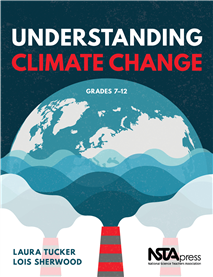Climate Change Studies: “What Have You Heard?”
Understanding Climate Change
By Laura Tucker and Lois Sherwood
(NSTA Press, 2019 – Learn more)

When I read the Acknowledgements for this book, I was actually very excited, as the authors are using this publication to update the GEMS publication, Global Warming and the Greenhouse Effect (1990).
I have used bits and pieces of that book for years in my classes, and was thrilled that this would be a much-needed update. I did think to myself “I hope they fixed that car exhaust lab.” (More on that later.)

The power of “heard”
The first session is “What have you heard about climate change.” What a spectacular idea, using the word “heard” instead of the more traditional “know.” This single verb frees students from any fears of committal. It allows students to add whatever they might have heard without any judgment about true, false, exaggerated, wild theories, political dogma, whatever.
Throughout the unit, the class revisits these ideas using evidence to support or refute them. It is such a simple concept to help students address misconceptions and track their understandings as they progress through the unit.
The unit moves in a continuum from teacher directed to student directed, as students add to their understandings. The second session is the original lab from the GEMS curriculum, using various sources to look for CO2 in the atmosphere. The goal here is for students to recognize that car emissions are a major source of CO2.
I got to say I groaned when I read this lab. First: it relies on balloons. Balloons are no longer allowed in my school. Why hasn’t someone made balloons out of Nitrile like gloves? I desperately need some. Then the very idea of sampling car exhausts with students just terrifies me. (Coughing, second degree burns, watery eyes. My principal looking at me over his eyebrows and clearing his throat.)
But I was determined to keep an open mind. So I read the entire session twice and watched the video on line, and many of my fears were allayed. I will try it myself first (of course) and recommend you do the same. The balloon issue remains a problem, though. If you have a solution… email me! (vbrackett/at/winslowk12.org)
Not just an update: An upgrade!
I will stop my blow-by-blow here and say that the book is not an update to the old GEMS book, but a tremendous upgrade. The handouts, graphs, data, etc. are all available online through the NSTA, with promises of keeping the data up to date as time passes.
The NGSS standards are referenced and highlighted within the presentation of each session. “Climate Change Agents” are also featured so students learn not just about the science but humans behind the science. And each lesson returns to the original “What have you heard” and allows students to revisit and revise based on evidence.
I was concerned that the focus of the unit would be greenhouse gases, which is an oversimplification of Climate Science, but as the unit progresses, more and more concepts are introduced through student research which leads to a climate “conference.” Students then take on a topic in much greater depth and expand their research with encouragement to utilize community-based resources, and finally search for solutions.
A comprehensive look at climate change complexities
For those of you looking for a few lessons to add to your climate unit, this is probably not the book you are looking for. However, if you are like me, searching for a comprehensive way to explore the complexities of climate change, address student (and popular) misconceptions, and our search for solutions, this book is definitely worth your time (and money!).
For the past 20 years Virginia Brackett has been teaching middle school science to gifted and talented students at Winslow Junior High in Winslow, Me. Teaching is her second career. Her first 15 years were spent as the Laboratory Director at a local sanitary district. She earned a Masters in Science Education from the University of Maine and has achieved National Board Certification.

































